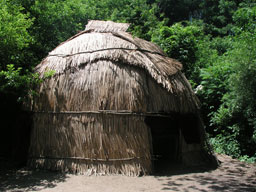Study Guide Household

Table of Contents
Wampanoag Style Houses
 Although the illustration from the 1830 edition of Mayhew’s Pious Indian Women depicts Wampanoag families living in plank board homes, wigwams (or wetu) appear to have been the dominant form of Wampanoag housing for the period in which Experience Mayhew writes (Scott I.54). Those Wampanoags who did build English style houses often retain some of the distinctive features of wigwams (Plane 106). Wigwams were an inexpensive and flexible form of shelter: built out of wooden poles and removable mats, these homes were easily transportable when the Wampanoags moved between seasonable hunting and planting grounds. Wigwams were also well adapted to the island’s climate. Wigwams could be double matted with eelgrass stuffed in between, a technique that made the houses warmer than many Puritan-style dwellings. This technique may have inspired the use of eel grass for insulation in Puritan homes on the island (Scott I. 52). European style houses also influenced wigwams: during the eighteenth century, some wigwams were modified to include boards, brick, stone, glass, and other European elements (Plane 106).
Although the illustration from the 1830 edition of Mayhew’s Pious Indian Women depicts Wampanoag families living in plank board homes, wigwams (or wetu) appear to have been the dominant form of Wampanoag housing for the period in which Experience Mayhew writes (Scott I.54). Those Wampanoags who did build English style houses often retain some of the distinctive features of wigwams (Plane 106). Wigwams were an inexpensive and flexible form of shelter: built out of wooden poles and removable mats, these homes were easily transportable when the Wampanoags moved between seasonable hunting and planting grounds. Wigwams were also well adapted to the island’s climate. Wigwams could be double matted with eelgrass stuffed in between, a technique that made the houses warmer than many Puritan-style dwellings. This technique may have inspired the use of eel grass for insulation in Puritan homes on the island (Scott I. 52). European style houses also influenced wigwams: during the eighteenth century, some wigwams were modified to include boards, brick, stone, glass, and other European elements (Plane 106).
Wampanoags in colonial New England tended to build two types of wigwams: a smaller "round house" or Puttuckakuan, and a larger arborlike “long house,” the Neesquttow, or "house with two fires.” Puttuckakuan were most likely single-family dwellings whereas Neesquttow could hold up to four families. The averageNeesquttow ranged from twenty to one hundred feet long and up to thirty feet wide (Nanpashamet). In Light appearing… (1651) Thomas Mayhew Jr. describes the island wigwams as “made with small poles like an arbor covered with mats, and their fire is in the midst, over which they leave a place for the smoak to go out at” (Eliot & Mayhew 5; Scott I. 50-52).
As William Wood and other colonists noted, women were the primary builders of wigwams (Scott I. 52; Quoted in Cummins 20). During their menstrual cycles, women lived separately in temporary shelters (Williams). Although Puritans did not separate from women during menstruation, the wigwam’s impermanence, fluidity, and seeming lack of personal space bothered Puritans, who encouraged converts to at least provide dividers so that sexual relations were kept more private from the rest of the family (Plane 98)
Items Related to Wampanoag Style Houses in the Archive
Overview < Previous | Next > Puritan Style Houses